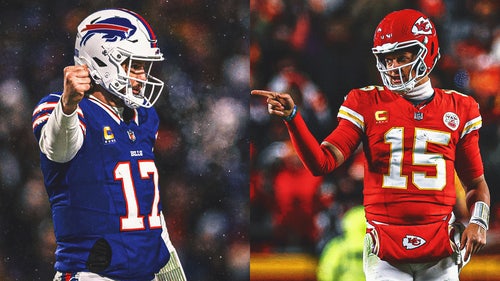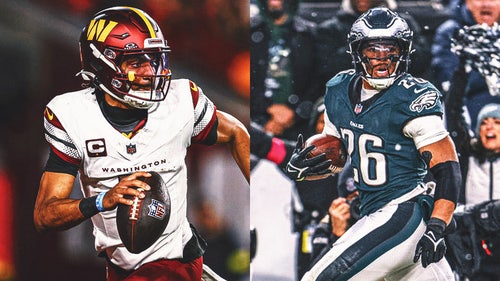
Why NFL's new command center will make reviews more efficient
NEW YORK — Upon further review, there is no disputing 88 television monitors. I now have indisputable video evidence.
After an all-access look at the new Art McNally Game Day Central room at NFL headquarters, I think this is one of the best moves the NFL has made in a long time.
It's incredible.
"It," is the NFL's state of the art replay facility. And it's so appropriately named. Art McNally was a legend in the NFL officiating world. He was an on-field official for nine years and then the Director of Officiating for 23 years.
When I left the NFL as the VP of Officiating, we had 10 televisions to monitor replays. And listen, it wasn't that long ago. We're not talking the stone age, folks. It was only five years ago. And when I heard about what the NFL was doing, going to a centralized replay system, I have to tell you, I was a little apprehensive about it.
But after seeing the room in action this past weekend and how the process will work, my conclusion was it's, well, incredible as I've said.
Included as part of those 88 monitors are 16 replay edit stations, with a four-square bank of monitors at each. The top left monitor brings in the game feed from the satellite truck. The screen at the top right is what the replay official will be looking at from the game site. Bottom left, is the operator's touch screen that will populate with all of the replays that have been shown and the bottom right screen is where New York can monitor any version of the replays they want, way before the referee has a chance to look at them. And just for good measure, there's a 90-inch monitor at the end of the room where players look larger than life.

A four-square bank of monitors will be at each replay station.
The goal is to be more consistent with the replay calls ... and to be quicker.
Last season, there were 435 replay reviews during the regular season, with an average of 1.7 per game that took an average total 2:33 per play.
Enter Dean Blandino, the NFL's VP of Officiating. He not only spearheaded this new program for the NFL, he was a part of the replay system the league developed in 1999.
But to understand where things are today, you have to go back to a play at the end of the 1998 season to understand how far the NFL replay review system has come. It was a play, that I think, will go down as one of the biggest plays in NFL history.
The game took place at the Meadowlands and it was between the Jets and Seahawks. The Jets won the game, 32-31, after the officials ruled that quarterback Vinny Testaverde had scored on a fourth-down, five-yard quarterback sneak with 20 seconds go. However, Testaverde never made it into the end zone and television viewers saw the replay over and over again. But there's a catch. The NFL didn't have replay then.
"That play was such a watershed moment for the NFL because it really was the last straw in terms of going to replay,'' Blandino said. "Back in '99, we said we had to design a system and we had different vendors come to New York and we came up with a challenge system. We came up with the touch-screen technology and digital recording of the feeds and it's evolved since then.''
The NFL wasn't the first to go to this centralized replay system, the NHL was. The NHL's "Situation Room" in Toronto began using its replay system prior to the 2003-04 season. It became the standard for replay that has now been adopted by all four of the professional sports leagues including Major League Baseball, which started prior to this season, while the NBA will begin in Oct. when its season begins.
Technology is an amazing thing, but it doesn't come without its challenges.
"First of all, we had to get the feeds back to New York in real time. We couldn't be seven to eight seconds behind because then the system wouldn't work," Blandino said. "Overcoming the delay was probably the biggest challenge and then it was the audio communication, where we have all seven officials communicating with each other wirelessly, but we needed to link into that system so we could speak to the referee and the replay official."
I think this new system will make the replay review process quicker and more efficient. I know both of those gave Blandino a little anxiety.
"Absolutely,'' Blandino said. "That was a big concern of stopping the game and delaying it for three minutes at a time and I think we are going to be more efficient because we can review things even before there's a challenge.
"If there's a tight play at the sideline, I'm already looking at it before the coach is throwing his flag. I can give the referee that information as he's coming over to the monitor and we can spend less than 60 seconds looking at it, come to a decision and move on.''
So who is the ultimate decision maker -- Blandino and his New York crew or the referee? Will the referee really overrule his boss?
"Well, I think it's still the referee's decision,'' Blandino said. "We'll consult, but our job here, and my job, ultimately is to make sure the referee doesn't make a mistake. And that's the process we put in place and that's how we're going to move forward."
I have to say, seeing the amazing technology and seeing all of the information they are culling from actual games, almost makes an old VP of officiating want to get back into the game.
Uh, upon further review, I think I'll pass. Making several trips to the golf course each week is about the only thing I want to replay.
2013 NFL REGULAR SEASON IN REVIEW
— TOTAL REPLAY REVIEWS: 435
— TOTAL REPLAY REVIEWS THAT OVERTURNED OFFICIALS' ON FIELD RULING: 170
— TOTAL COACHES' CHALLENGES: 157
— TOTAL COACHES' CHALLENGES THAT OVERTURNS OFFICIALS' ON FIELD RULING: 74
— TOTAL REPLAY OFFICIAL REVIEWS: 278
— TOTAL REPLAY REVIEWS THAT OVERTURNED OFFICIALS' ON-FIELD RULING: 96
— SCORING PLAYS REVIEWED: 116
— SCORING PLAYS OVERTURNED: 33
— TURNOVER PLAYS REVIEWED: 117
— TURNOVER PLAYS OVERTURNED: 53
— AVERAGE TIME OF REVIEW: :47
— AVERAGE TOTAL DELAY: 2:33
— REVIEWS PER GAME: 1.70
— DELAY PER GAME: 4:20
— GAMES WITH NO REVIEWS: 49 out of 256 (19%)
— TV TIMEOUT DURING REVIEW: 297









